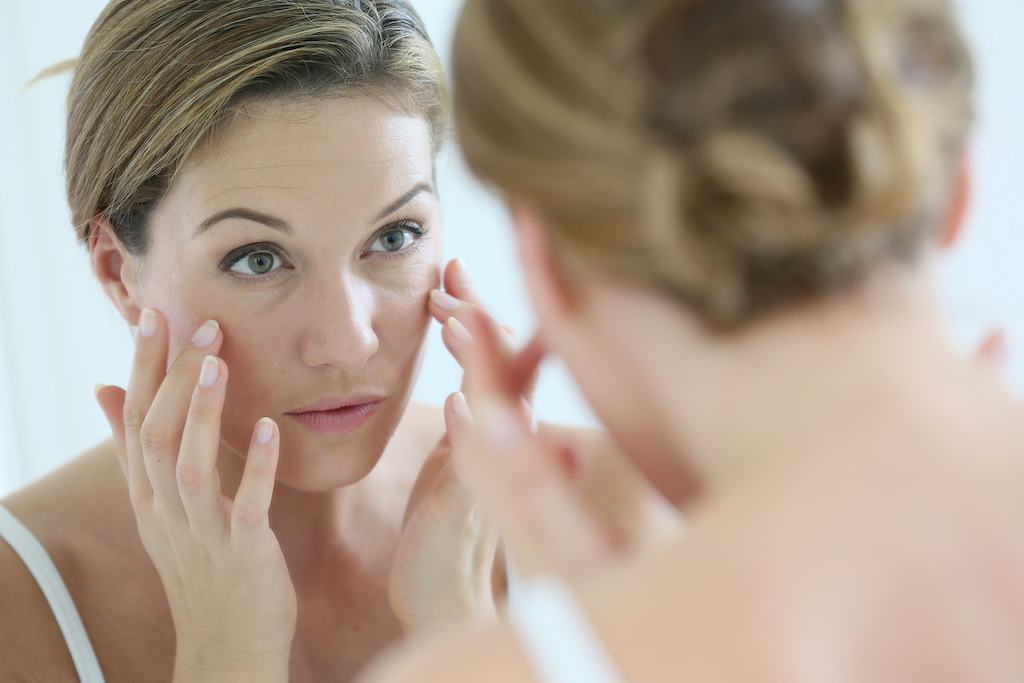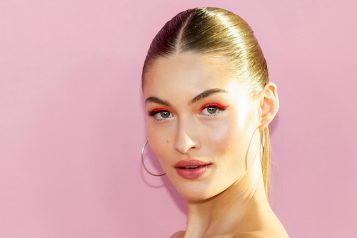Mara C. Weinstein Velez, M.D., FAAD is a board-certified dermatologist, and Director of Cosmetics and Laser Surgery at the University of Rochester Medical Center, in Upstate New York. Dr. Weinstein-Velez completed a prestigious Laser, Cosmetic and Dermatologic Surgery fellowship at SkinCare Physicians in Boston, with clinical faculty from the Harvard and Yale Departments of Dermatology and is one of the only Fellowship-trained Cosmetic and Laser Surgeons in Western NY.
Haute Beauty expert Dr. Mara Weinstein-Velez explains what happens to our aging faces and what skincare treatments help best.
 Photo Credit: ShutterstockAging is not a choice. There are natural changes that occur with the skin over the decades. The rate at which we age can be due to genetics, physiology, photoaging, pollution, and stress among many of life’s issues. Physiologically, as we age, we tend to lose volume in our face, especially in the cheek and temple areas. The bones supporting our eyes become wider and longer (the eye socket) and the length and height of our lower jawline decreases, making it less well defined. Also, the space between the base of the nose and upper lip (cupids bow) widens making the upper lip appear flatter and longer.
Photo Credit: ShutterstockAging is not a choice. There are natural changes that occur with the skin over the decades. The rate at which we age can be due to genetics, physiology, photoaging, pollution, and stress among many of life’s issues. Physiologically, as we age, we tend to lose volume in our face, especially in the cheek and temple areas. The bones supporting our eyes become wider and longer (the eye socket) and the length and height of our lower jawline decreases, making it less well defined. Also, the space between the base of the nose and upper lip (cupids bow) widens making the upper lip appear flatter and longer.
Collagen and elastin are responsible for the skin’s elasticity, keeping our skin tight and youthful-looking. As we age, our body slows the production of collagen and elastin. Sun exposure, environmental pollutants, stress, and illness can introduce free radicals into our skin, which only speed up the process of aging causing the destruction of collagen and elastin. This results in loose, sagging skin with little elasticity and wrinkles that stay in place even when we are not making natural expressions. This is the difference between static wrinkles and dynamic wrinkles.
Luckily, board-certified dermatologists have licensed physicians who are highly educated on the facial aging process but also have the tools to not only slow the process but also reverse the signs of aging, to keep you looking like a natural but better version of yourself. Stick to a maintenance plan and you will be decades ahead!
In your 20s
See your dermatologist for evaluation even if don’t have specific concerns. They will check your skin for any irregular appearing moles or growths and can help guide you with a plan for best skincare practices. See your dentist regularly to make sure your teeth are healthy and to maintain good oral hygiene, as the teeth maintain the underlying bone structure of the jaw. Keeping that youthful jawline (no jowling!) starts at the dentist. Usually, skin is taught in your 20s with little wrinkling, but you may have some sunspots developing.
At-home skincare regimen in your 20s
– Wash at least once daily with a gentle cleanser
– Apply an antioxidant serum to prevent free radical damage from sun and pollution
– Apply a daily facial moisturizer with SPF 30 or higher – try a tinted moisturizer with iron oxides for extra coverage from visible light, especially if you have melasma
– Apply eye gel or cream daily; gels if your skin is oily, and creams if you run dry
– Use a lip gloss with SPF daily
– In the evening, use a retinoid cream to boost collagen production and even skin tone (retinoids are prescriptions and retinol are over the counter)
– If you are going on vacation, at the beach, or in the sun longer than 2 hours, use a broad-spectrum sunscreen (UVA/UVB protection) and apply SPF over 30 every 2 hours (a shot glass amount is how much is needed to cover the entire body).
At the dermatologist in your 20s
Your late 20s is a good time to consider preventative treatment with neuromodulators like Botox/Dysport/Xeomin. At this age, it’s likely only needed twice a year. The earlier you start, the less you will need it over time as your muscles will learn not to frown all the time. If you already have brown spots and enlarged pores, consider monthly peels (salicylic acid, glycolic acid, Vi Peel, or Jessner’s) or light laser treatment, such as the Clear+ Brilliant or a laser toning procedure with the Pico or Laser Genesis. Both have minimal downtime and are considered lunchtime procedures for maintenance.
In your 30s
This is when your skin can start to show fine lines and becomes duller. You may start to notice static wrinkles on the forehead and glabella (frown lines) and brown spots. There might also be some volume loss in the cheeks and the nasal labial folds.
At-home skincare in your 30s (in addition to regimen above…)
– Add a cleanser with AHA/glycolic acid to gently exfoliate 2 – 3x per week
– Continue a daily antioxidant serum
– Daily sunscreen! SPF 30 or higher with physical blockers and iron oxides to block visible light
– Eye cream AM/PM
– Retinoid nightly
– Consider serums with growth factors and peptides to stimulate collagen production regularly
At the dermatologist in your 30s
Now is the time to add regular use of neuromodulators every 3 – 4 months. It’s also a good time to check in with your dermatologist about fillers, especially in areas where we tend to lose volume first, such as the midface and around the eyes, creating that hollowed, tired look. Start to address texture irregularities of the skin surface left behind from acne scars or sun damage/indoor tanning. Consider a nonablative fractionated laser or hybrid laser-like the Halo Pro, Fraxel, or PicoGenesis FX monthly until they are softened (it may require 4 – 6 treatments) with the added bonus of boosting collagen and elastin production with these devices.
Consider microneedling or the Clear+Brilliant for maintenance quarterly. They both have minimal downtime and are typically less expensive. Microneedling creates microscopic wounds in the dermis, which stimulates a wound healing and repair response that encourages neocollagenesis and neovascularization (new collagen production and new blood vessels to nourish the repair).
Address those brown spots! Your age is easily detected by the number of brown spots you have on the skin (hands, neck, chest, arms). Work to lighten them in order to give the surface of the skin a more even skin tone. Studies have shown that by evening out the color of the skin, you can take 6 – 12 years off! Consider IPL, Enlighten (Picosecond Laser), Clear+Brilliant Permea for easy, minimal downtime procedures, requiring 2 – 4 treatments to see a significant reduction.
 Photo Credit: ShutterstockIn your 40s
Photo Credit: ShutterstockIn your 40s
Now is when your skin starts to look tired and begins to lose its bounce. Skin also feels rougher, drier, and bruises more easily. You probably have more hyperpigmentation and deeper expression lines if you are just starting a skincare routine at this stage.
At-home skincare in your 40s (in addition to the regimens above…)
– Use a rich moisture cream at all times containing lipids and ceramides to restore moisture barriers, which is lost with age
– Choose an eye cream with peptides and growth factors
– Continue to exfoliate with a chemical exfoliant weekly
– In addition to a retinoid, start regular use of creams or serums with peptides or growth factors
At the dermatologist in your 40s
Skin tightening! Ultrasound or radiofrequency devices help to tighten the skin. There are many different options. Think of these procedures as a way to rebuild the foundation of the facial structure. Once you have a solid foundation, you can continue to build from the bottom up to help create a better, more youthful version of your 40-year-old self. These procedures tend to be on the pricier side but the results are long-lasting and worth it. The changes are subtle but noticeable. The best part is that there is no downtime. Repeat every 18 – 24 months for lasting results. After all, we keep on aging so it’s a constant battle against time.
In your 50s
If you have read this far, the 50s is a time to really get into a maintenance regimen and keep it! The ideal 50s+ antiaging regimen looks something like this:
At-home skincare in your 50s
In the AM
– Cleanser or cream with an AHA like glycolic acid (1 – 2 times a week), otherwise use a gentle creamy cleanser (for dry skin) or foaming (for oily skin)
– Antioxidant serum
– Eye & neck cream
– Moisturizer
– SPF 30 or higher
In the PM
– Cleanser (consider double cleansing if you wear makeup)
– Peptide/growth factor serum
– Eye & neck cream
– Retinoid
– Moisturizing cream if your skin runs dry
At the dermatologist in your 50s
Keep it simple! There are only 4 – 5 musts for your maintenance plan; everything else can be considered fine-tuning. There are so many new lasers and technology on the horizon, but if you start with these simple procedures and do them regularly, you are guaranteed to always be up to date with anything that is developed. You and your dermatologist can work together to decide what else you may need.
– Neuromodulators every 4 months on average to treat crow’s feet, glabella, and forehead. This is your workhorse and you must continue to maintain it! Regular neurotoxin injections act as a good “check-in” with the dermatologist 3 times a year to make sure you are on the right track with your regimen and to check in to see if there is anything new on the horizon – there are always new and updated treatments in the works!
– Fillers for the cheeks, under eyes/ tear troughs, lips, temples, chin area, and hands every 6 – 9 months. You may not need this often, but check in with your dermatologist during the neuromodulator visit.
– Skin tightening (face, neck, chest) every 18 – 24 months.
– Skin resurfacing (face, neck, chest) to treat texture, tone, and pore size with a non-ablative fractionated or hybrid laser). Initially, 4 – 6 sessions spaced 4 – 6 weeks apart to make the most dramatic difference with minimal downtime. Then continue 2 times a year. Or try IPL initially 1 – 3 sessions every 4 – 6 weeks ideally (in the Fall or Winter) then once a year.
For more information, visit Dr. Brian A. Levine's social media:

























